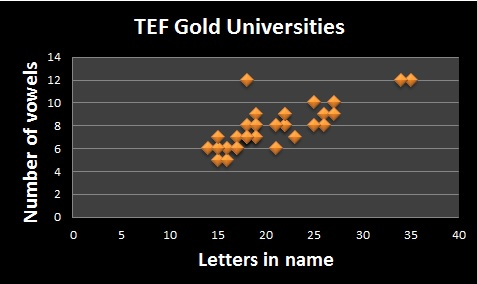Breaking: the LSE, with a bronze ranking, rubs shoulders not only with other 'top' (AKA TEF bronze) universities but worryingly loads we've never heard of. But despair not, a properly authoritative ranking (Times Good University Guide) will put us straight again.
Since publication of the Teaching Excellence Framework (TEF) results last Thursday June 22, damage limitation has included some or all of the following: damning with faint praise, references to provisional, a first take, acknowledged flaws ironed out in future iterations, etc. Of course the not so subtle message from distractors, paraphrased above from the Sunday Times leader, is that 'anomalies' (ex polys getting gold) will be rectified and the 'top' returned from exile in the Bronze Age before too much harm is done.
My beef is not with a desire to refine TEF metrics in future, rather the sheer bad grace of those intent on trashing its outcomes. It's difficult to overstate what gold means to a teaching-focused university like Northampton. Likewise, it's hard not to take criticism that the TEF is "meaningless" from senior leaders personally.
Until now, journalist-compiled league tables done to sell newspapers have been a mixed blessing for institutions like mine. Just 12 years old, we don't have the longevity and brand awareness of the former polytechnics let alone the well-earned reputations of universities founded centuries before. So being lobbed in with them and judged on terms favourable to the established elite is a challenge. Research is an obvious example. But more insidious is the weighting placed on entry tariff as a proxy of quality. Why should some universities be penalised in commercial league tables for taking working class and BME students who may do less well in A-level grades, all being equal, than their middle class counterparts? Interesting then that The Guardian, voice piece of the many not the few, has increased its weighting towards entry tariff points, entrenching the positions of the established elite. Who decides these weightings? I can't imagine any of their journalists were privately educated. In the post-analysis frenzy it is a joy to see trade publications like the Times Higher Education, who earn a living compiling league tables no-one asked them to, churn out all manner of cross-correlated comparing apples with oranges, In similar fashion I have done my own highgly revealing analysis below.

Despite this insight, the clustering of high NSS satisfaction scores across the sector, something to be cheered, can have negative effects. In the Complete Guide, renormalised NSS outcomes for student satisfaction on a scale of 1-5, the biggest contributor to table position - span 3.75 to 4.45, a range of just 0.7 across 100+ universities! On this score, a swing of just 0.1 will take you 34 places up (or down) the table. How reflective is that of teaching quality? It is instructive to read the comments posted in response to Chris Husbands TEF article in the Guardian Higher where critics seem to be arguing in favour of exactly this kind of absolute ranking, comfortable with a narrow focus on inputs and outputs as opposed to outcomes al la TEF.
Still, it will be interesting to see how publications that make money from league tables incorporate the TEF results. Perhaps they will ignore it, given its outcomes to some extent threaten the hierarchy constructed and sustained for many years. They may argue that, unlike the REF, including the TEF amounts to double counting . Or simply dismiss it as irrelevant like the Sunday Times.
My hope is that TEF outcomes based on relative benchmarking are accepted quickly by universities. Continued quibbling including mooted legal challenges pose an unwelcome distraction, analogous to donnish equivalents of Remoner and Brexiteer, firing salvos that fracture and weaken the sector. Despite the sporting metaphor behind the rankings, point scoring in public will not end well. The country is divided enough as it is.
Perhaps a way forward for a revised TEF is to apply some metallurgy to expand the grading options? Gold and silver are naturally occurring metals while bronze is an alloy of copper and tin. But precious metals have alloys too - Electrum, a mix of gold and silver, and Corinthian Bronze, an alloy of copper, silver and gold. Clearly the elements can combine together, as universities must post TEF. Just don't mention platinum.
